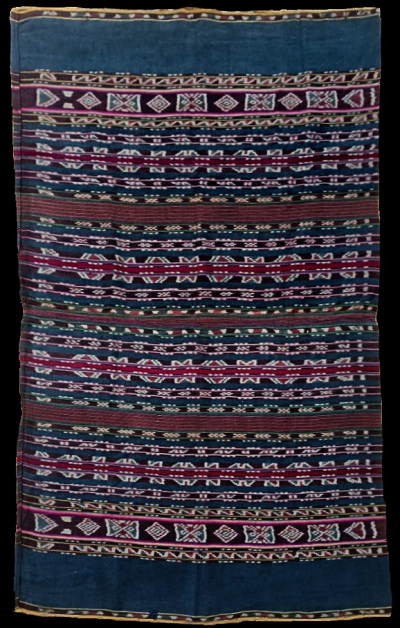| |
 
 | | | |
343 Solor Archipelago, Pantar
Kafate (sarong)
| | Locale: | Collected in Bumang village in Kecamatan Pantar Tengah, which translates as Central Pantar, but is really the south. Desa unknown. Made by Alurung (Alurese speaking) people. | | Period: | | | Yarn: | Cotton, hand-spun, medium, and silk pinstripes | | Technique: | Warp ikat | | Panels: | 2 | | Design: | Antique two-panel kafate, type yet to be determined. The main field is decorated with multiple design stripes. The overall lay-out, with a midfield bordered by two wide plain bands, and narrow ikated bands at the extremities, is the same as that on all Pantar sarongs. The design is quite unique though, and was not encountered elsewhere. Some of the motifs recall the drawing style of Ternate, which lies between Pantar and Alor, but the overall design is different from any Ternate sarongs. A characteristic aspect shared by some Pantarese regions, Ternate and a part of western Alor, is the drawing technique. Motifs are drawn in white outline, and the enclosed areas are dyed in a solid tone. This is typically done in a maroonish morinda, or a greenish blue, a pale petrol, which makes its ikat instantly recognizable. The region clearly forms a cultural whole, but with strong regional differentiation and differentiation by descent line, It must be remarked that the said drawing style and the greenish blue are also found in parts of Lembata, | | Comment: | [PHOTOGRAPHY PROVISIONAL] This two-panel ceremonial sarong was acquired from Helang Topu, the grandchild of the weaver, Tabita Helang. We would have estimated this cloth to have been made in the 1930s, but the family which sold it, quoting its genealogy, insists that it was woven around 1920. The sarong was a treasured family heirloom, always kept in the lombia, a space under the roof beams for storing pusaka. | | Background: | Chapters on Solor Archipelago and Pantar. | | Compare: | 184 247 314 315 339 | | |

©Peter ten Hoopen, 2025
All rights reserved.
|
|


